
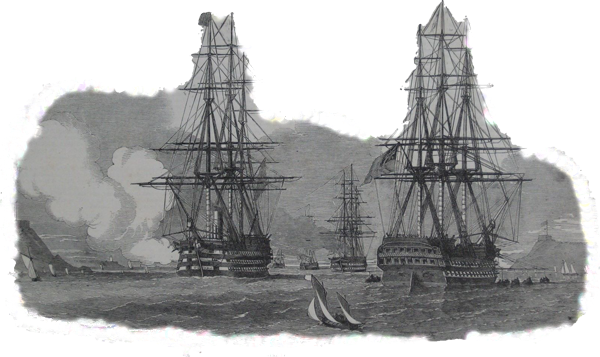
In the 18th and 19th Centuries, the demand for sailors for both the Royal Navy, and the British merchant fleet was insatiable. In part the need was met by charitable societies, such as the Marine Society who purchased and set up the first static training ship, the Beatty, in 1786.
Over the course of the next hundred years, charitable associations and private educational establishments leased retired sailing ships from the Royal Navy, for use as static hulks, in order to train boys in the rudiments of seamanship. There was both an altruistic and practical motive behind the setting up of many of these mobile nautical schools.
It was felt that removing boys from the slums of 19th Century British port cities, and giving them the skills to serve as seamen, would enable these boys to have a productive life. The training of these boys also provided much needed manpower for the expansion of the British Empire and her military forces.
Since the 17th Century, The Royal Navy itself, had three forms of direct recruitment of seamen.-
Those who volunteered as boys, aged 13 to 16, and went to sea.
Qualified seamen, who joined the navy, because there was the prospect of permanent, pensionable employment. The wages in the navy, however, were poorer than those in the merchant fleet.
The third was the most contentious form of recruitment. In time of war or emergency , since the time of Elizabeth I, there was the so-called ‘impressment’ or the ‘press’. This was a form of legal kidnapping, where so-called press gangs, would roam seaports with a warrant to take sailors and sometimes landsmen as crew for naval ships. In extreme circumstances a ‘hot press’ could take place, in which even those seamen normally exempt from service were also taken.
In April 1808, a 'hot impress' took place at the Cove of Cork. It was remarked that a number of useful hands were procured for the navy during this operation.
By the 1830’s, the use of the ‘press’ had all but finished, but the problem still remained of the inability to man the ships of the navy.
In 1838, Captain Lihou, R.N., published a pamphlet which received widespread publicity. In it, he proposed that the navy itself, should establish a series of static training ships at the major ports of the British Isles. These ships would form floating nautical schools, for the entry of boys between 13 and 16 years old for a life in the navy.
The Admiralty eventually acted, and in 1855, the first naval training ship was established. This was the Impregnable (1810). This was followed by the Implacable (1805), Ganges (1821), St Vincent (1815) Boscawen (1844),Minotaur (1863) and Caroline (1882).
In Ireland, there was a long tradition of boys and men joining the British Navy. Irish seamen were well regarded, and it was seen, for many Irishmen, as one of the only opportunities to earn, by the standards of those days, a living wage, with chance for limited promotion. The attraction of a pension, in an era when this was almost unheard of, was also a great draw.
Irish politicians and business leaders, had agitated constantly, for increased investment by the Royal Navy, In Ireland. The advent of the static training ship system for boys, was seen by many, as an ideal opportunity to increase the importance and prosperity of an Irish port. The competing parties campaigned for Belfast, Kingstown (Dun Laoghaire), Queenstown (Cobh), or Galway, to have a training ship based in their respective ports. It was to be many years however, before any training ship was assigned.
The Apprentice Brigs
For the aspiring officer class, there were a number of seagoing training ships. These ships, usually small brigs, would give the apprentices the experience of life at sea before joining a regular navy ship.
The Cherokee Class brig, HMS Wizard , was based in Cork, Ireland, from 1850 to 1859. In 1854. The little six-gun, Wizard had the dubious distinction of becoming the Flagship of the Coast of Ireland, after the withdrawal of HMS Ajax . This was seen by local figures of authority as being very demeaning, as they were used to having a large warship permanently moored in Harbour.
In 1855 the Wizard , suffered the ignomy of running aground on the Spit Bank, in full view of the people of the newly named Queenstown. She lay on her beam ends, until kedged into deeper water.
The end for the Wizard came in February 1859 . She had been on manoeuvres with the Channel Squadron along the south coast of Ireland since January. Her role was training midshipmen for service on ships of the line.
On the night of Wednesday the 8th, the seas were running heavy, with a gale from the SSW. The Wizard , under command of Lieutenant A.P. Helby, was attempting to enter Berehaven Harbour when she missed stays (the old nautical term for failing to tack) and went hard aground on the Roancarraig Rock. The ship lay for two hours in the thundering surf. The crew fired guns to try to attract attention, but locals thought it was just the Channel Fleet continuing with firing practice at sea.
Men of the Adrigole coastguard spotted what was happening, and under the leadership of local man Cornelius Sullivan, two boats went to the now rapidly breaking up wreck
The larger of the two boats was manned by Cornelius Sullivan, Jeremiah Sullivan, Michael Harrington, and two coastguards, McDonnell and Barrett. The smaller boat was crewed by Florence Abbot and Timothy Sullivan. When they arrived at the wreck there was a scene of pandemonium with the ship broken into two halves, and the men clinging to the bulwarks.
Cornelius Sullivan skilfully backed his boat to the wreck, and time and time again rescued the men from the wreckage.
The smaller boat was used to transfer the survivors to the mainland. In all, the entire crew of 42 was rescued from the Wizard , due to the bravery of the Dereeney boatmen, and the two coastguard men. It took seven voyages to the wreck to accomplish this.
Later that night Cornelius Sullivan and his crew rescued five local men from a boat that capsized while trying to recover floating wreckage from the Wizard .
Lieutenant Helby of the Wizard , was court martialled, but was cleared of any negligence or wrongdoing.
HMS Wizard was replaced by the brig HMS Ferret in April 1859, which served as apprentices training ship in Queenstown, until June 1864, when the Ferret was relocated to Southampton. From this point in time, to late in the century, the island of Ireland was without a naval training ship.
The stationary training ships were not the only way of taking on and training boys. Since 1894, HMS Northampton had done duty as a sort of mobile recruiting station. She sailed to all the major ports of the British Isles, including Cork, Dublin, and Belfast. Boys over the age of eighteen, were accepted as trainees, and did seagoing training on the old cruiser for 4 to 5 months. These recruits were in turn, put on board the ships of the training fleet, such as the Curacoa and Calliope.
They were taken on a six week training cruise, in which they learned the rudiments of gunnery, and crewing a man-of-war. At the end of the six weeks, they were assigned to regular naval ships. There was continual debate as to whether the seagoing method, or the static training ship was the most efficient in producing useful naval personnel.
There was an embarassing mishap to HMS Northampton in May 1904. She grounded heavily on the Spit Bank, opposite Queenstown. She remained fast for 24 hours until towed free by HMS Aeolus and HMT Stormcock .

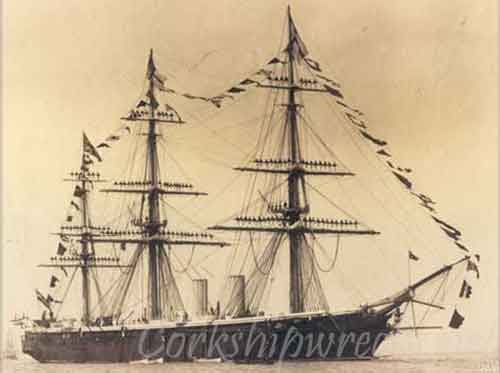
HMS Black Prince , with yards manned
Intense lobbying for an Irish training ship continued on behalf of Irish interests. In the latter half of the 19th Century, a positive outcome was achieved, mainly as the result of efforts of Cork Nationalist MP, Captain Anthony Donelan. He asked numerous questions in Parliament, about the possibility of basing a training ship at Cork. He was also very concerned about the under-utilisation of Haulbowline dockyard.
In 1895, plans were in place to send a training ship to Cork. Initially it was planned to send HMS Minotaur , and with this in mind, the Admiralty set about organising a training ground, for the boys. In 1896, George Goschen, the First lord of the Admiralty made the order, and it was decided to send a different training ship, to be based in Cork Harbour.
Chart portion, showing the location of the boys training grounds, the mooring location of Black Prince, and the location of the Black Prince pier
The ship chosen, was HMS Black Prince , which when launched in 1861, been the pinnacle of warship design. Alongside her sister ship Warrior, she was one of the first true ironclad warships, consigning the wooden ships of the line to history. For a time these two ships were impregnable, but technology quickly passed them by. Soon the Black Prince was in reserve in Devonport.
 The crew and boys of the Black Prince
The crew and boys of the Black Prince
On February 5th 1896, the Black Prince arrived in Cork Harbour to great fanfare. The arrival of the ship was seen as a vote of confidence in Ireland, and it was a demonstration of the committment of the British government to the future of Cork as a major naval base.
The Black Prince needed major reconstruction, to make her suitable as a training ship, and the work was allocated to the Passage Docks Company, about a mile upriver from Queenstown. Initially the conversion work was estimated to take about three months, at a cost of £8,000.
The ship lay idle at anchor until June of that year, when she was brought to Passage. Work commenced, but by November 1896, another £2,000 had to be allocated to complete the works on the ship.
The permanent mooring for the new training ship was to be in Monkstown Bay, west of Queenstown. It was felt that this position would keep the Black Prince well out of the way of passing shipping,(it was not to be the case).
The search continued for suitable training grounds in the harbour. Protracted negotiations were held with local landowner Mr Walton, of Prospect Villa, in Ringaskiddy. It was essential that the training ship had access to grounds, in which the boys could take part in sports and games .
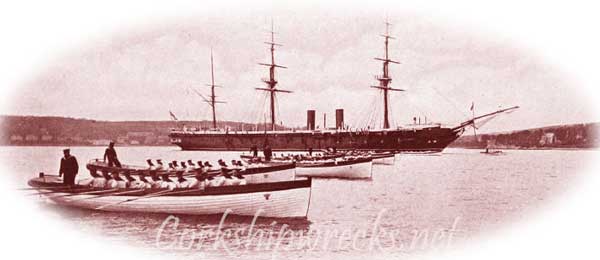
Whaleboats racing, with Black Prince in background
The location in Ringaskiddy was felt to be very suitable for the boys as it was remote, with little chance of the boys being led astray. The rent of the recreation grounds was fixed at £25 per annum.. The site chosen was the field behind Mr Walton's house, Prospect Villa.
To access the grounds, it was necessary to build a large wooden pier across the mudflats, so that the whaleboats of the training ship had access. The length of the pier eventually built, was over 600 feet, this guaranteed a depth of four feet, at LWS. This pier was gradually known as the Black Prince pier.
It was was not until May 1897, that the Black Prince commenced her new role, as static training ship. She was moored in a position in the bay, adjacent to the Oyster Bank. The Black Prince commenced operations under the command of Captain Robert Langdon.
She had a capacity for 450 boys, and in 1899, was almost full, with 420 boys on board. The boys did not just come from Ireland, but from the north of England and Scotland also. The training, which lasted approximately 16 months, consisted of all the various aspects of seamanship, gunnery, cutlass training and rifle drill.
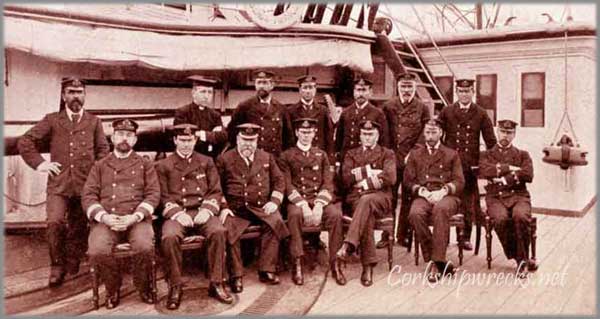
Captain Langdon, and the officers of the Black Prince
Swimming lessons were conducted in the frigid waters of Cork Harbour. Rifle firing practice was conducted ashore in the butts of Spike Island. This nearly caused an international incident in 1902, when shots fired during rifle practice struck the German training ship Heckla .
An important part of the boys training involved whaleboats, these were large rowing boats attached to vessels, used for everything from transportionto and from ships, to lifeboats in time of need. In the navy, whaleboat racing was a very competitive sport, and races would be held every year, involving crews from the training vessels throughout the British Isles. The boys of the Black Prince travelled regularly to these events.
Every Summer, there was a 'Boys Athletics Sports Day' held at the training grounds at Ringaskiddy. These days not only involved sports but band recitals and games.They were seen as an opportunity for families of the boys to attend, and see the progress of the young men of the Black Prince.
The position of the Black Prince mooring in Monkstown Bay was not without incident. On October 27, 1897, the sailing ship Autocrat , was being towed down river, when she collided with the Black Prince . The damage was superficial. On February 11, 1899, the steamer Westminster , on route to Passage Docks, collided with the Black Prince . One cutter was destroyed as well as superficial damage. On December 28, 1900, over £600 worth of damage was done to the ship in the course of a gale. On August 20, 1902 the steamer Planet bound from Cork to Bristol collided with the Black Prince . She struck on the starboard side and carried away two large cutters. The steering gear of the Planet was reportedly out of order.
In 1904, the Admiralty wanted the name of Black Prince , for a new armoured cruiser. Captain Donelan M.P. petitioned the Admiralty for the name change to reflect her importance to Ireland. The ship was renamed as HMS Emerald .
The success of HMS Black Prince/Emerald had been in decline since 1900. The attraction of the static training ships was eclipsed by more direct means of recruitment, such as the Northampton . On the Northampton , a trainee could be on a navy ship in 6 months, earning wages.
On the static training ship, it was at least a 16 months course. From the Admiralty point of view, the costs per boy on the static training ships were far more expensive than shore-based establishments, so they were gradually being phased out.

HMS Northampton in Queenstown 'roads', with HMS Black Prince visible in background
Eventually in late 1909, it was decided that there was so little demand for an Irish training ship that the Emerald had to go. At this point there were only 25 Irish recruits on the ship, the rest were made up from boys all over the British Isles.
In July 1910, HMS Emerald , without propulsion of her own, was taken in tow by the tugs Warrior and Hellespont , to be taken to Plymouth.
The weather was rough and the Warrior returned to Cork for assistance. The Emerald became unmanageable. Luckily the liner Deucalion arrived and helped with towing. The tow rope of the Hellespont broke, injuring a crewman. The Deucalion continued alone, and brought the Emerald safely to Plymouth.
The name of the Emerald was changed to Impregnable III , and she became part of the boys training establishment at Devonport. Once again, Ireland was without a Government training ship.
The only private training hulk in Ireland was The Grampian (ex HMS Gibraltar ) based in Belfast from 1896 to 1899. It’s mission was to educate destitute Protestant boys from Belfast and surrounding areas.

In 1912, Winston Churchill, First Lord of the Admiralty, visited Cork. Churchill, an ally of John Redmond, of the National Party., was questioned by local politicians about the absence of a training ship in Cork Harbour, and assured them of his best efforts to find a replacement.
In January 1913, it was announced that a new training squadron was to be based in Queenstown. This ‘Queenstown Squadron’ consisted of eight ships of the slightly elderly Edgar Class . They were -
Endymion
Crescent
Edgar
Hawke
Royal Arthur
Gibraltar
Theseus
Grafton

The Queenstown Training Squadron in Monkstown
Two of the ships were reserved for naval cadets, while the other six were for boys. The squadron was under the command or Rear-Admiral Sir Christopher Cradock.
In September 1913, Churchill arrived in Cork, on board the Admiralty yacht Enchantress. He was given a great welcome, as the Queenstown training squadron had brought great prosperity to the harbour area. In a speech, he assured the local deputation that the Queenstown base had been highly successful, and was to continue.

Two unnamed Edgar Class ships in Queenstown Roads
International events were about to overtake the Queenstown Training Squadron. War with Germany was declared in July 1914. In August of that year, the Edgar Class cruisers of the squadron were withdrawn from Queenstown. They became part of the 10th Cruiser Squadron in the North Sea.
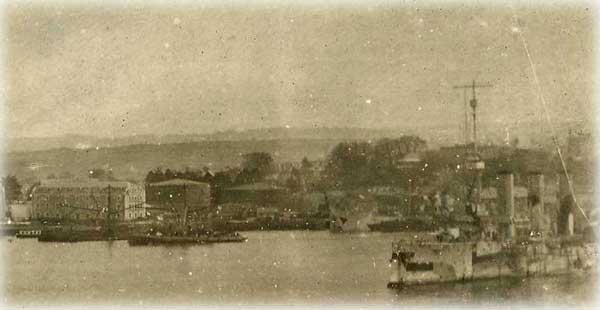
HMS Cumberland moored, with Haulbowline Island in background
The ending of World War One in November 1918, brought about great changes. The political situation in Ireland became more unstable, with violence against Crown Forces becoming more prevalent. Within the Royal Navy, there was massive post-war demobilisation, but there was still a need to train new cadets.
There decision was made to send the training ship Cumberland to Queenstown, in 1919. HMS Cumberland (1902) was an elderly Monmouth Class Cruiser, used to train cadets from Dartmouth College, as well as 'special entry' cadets from the public schools.
In hindsight, it seems amazing that the Admiralty felt it was a good idea to send a ship filled with trainee officers into a rapidly deteriorating political situation. Perhaps there was a need felt to show that it was 'business as usual'.
The Cumberland arrived in Cork Harbour, in February 1919, and was moored opposite Haulbowline Island. She was under the command of Captain Gordon Campbell VC, of Q-Boat fame, and had a full compliment of cadets. Training began, and the Cumberland and her cadets quickly became a fixture of Queenstown life.
When the ship was not on training cruises,the boys were continually allowed ashore for recreation, and played rugby matches with Cork colleges and schools
There never seemed to be the same animosity from the nationalist population to British naval personnel, as there was to the other military and police forces. Naval men and cadets of the 'Senior Service' seemed to be able to go ashore and travel almost at will, while other arms of the services were gradually being confined to barracks.
In April 1920, the Cumberland had reached the end of her useful life, and was put up for sale. She was eventually sold and scrapped in 1923.
In 1922 the Irish Free State was formed, and remained under Dominon status until 1937. While there was no longer a British naval presence ashore. The Treaty Ports remained under British Army control, there was also the presence of two or three destroyers of the Royal Navy on guard duty.
Even after the bloodshed and violence of the War of Independence, and the ensuing Civil War, Irishmen still flocked to join the British Navy, albeit at reduced numbers from before. The coastal towns of Cork, still provided large amounts of entrants, and parents of these youngsters tended to get retired Royal Navy officers, living locally, to write letters of recommendation and good character.
On the night of March 24, 1936, two men arrived at the door of retired Rear-Admiral Townshend Somerville, in Castletownshend, Co.Cork. The unarmed 73 year old opened the door, and was shot dead by the gunmen. Notes were left with the body, saying that the shooting was in retaliation for his help in recruiting for the British Navy. This act did not halt recruitment, which only appears to have tapered off in the 1950s'.
